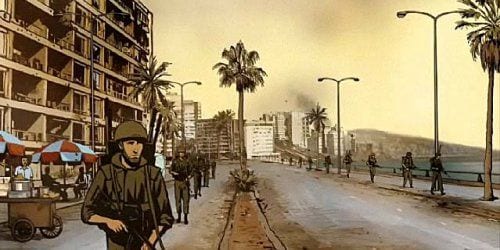
It’s an exercise in memory, an attempt to recall the unfathomable and unimaginable. It’s animation taking the place of atrocity, the literal spoils of war witnessed in stylized, striking visuals. It’s the story of men who would rather forget, of a time two decades before when the Middle East was measured by chest-pumping challenges and baffling back and forth advances. It’s a documentary and a denouncement, an explanation and an exaggeration – and in the end, it’s one of 2008’s best films, a wildly inventive and shockingly effective cartoon trance that takes us deep into the heart of human darkness and then delves even deeper.
But there is more to Ari Folman’s Waltz with Bashir than the story of middle aged men confused by their turn in the Israeli army circa the early ’80s. This is not just some explanation of how war is insane, allies are untrustworthy, and if one event can change an entire human being’s perspective on life. But Folman does fashion the kind of collective grieving process that puts us smack dab in the middle of an incongruous catharsis. On the one hand, our main character (the director himself), wants to uncover the meaning behind his frequent daydreams and half-hallucinations – the main one centering on a 1982 massacre at Sabra and Shatila in Lebanon. But this is not just an investigative journey into truth. Thanks to the artistic approach Folman decides to take, the true nature of conflict is unmasked.
The narrative is fairly straightforward given the almost 3D nature of the animation. This is a talking head experience taken to indescribably new levels. Folman decides to question everyone he can about the Israeli invasion, concentrating on those who, like him, were scared, wide-eyed teenagers at the time. His travels take him to Belgium, where one former friend immediately shoots down his version of events. Another colleague describes the initial invasion, including an argument over a gun that gives the movie its unusual name. Finally, Folman finds a kind of consensus, and moves on to interview those people – officials, officers, reporters – who had first hand knowledge of the horrific events at Sabra and Shatila. In combination, Waltz with Bashir becomes the best of all possible documentaries – wildly entertaining, keenly informative, and wholly unforgettable.
Folman’s choice of mediums is part of the film’s inherent magic. The use of stylized images helps amplify the horrors these young men had to face. An opening dream involving ravenous, rabid dogs leads to a highly disturbing admission, while a later sequence involving an orchard, a division on alert, and a small boy carrying an RPG is particularly memorable. All throughout Waltz with Bashir, the use of animation takes the filmmaking to a whole new level, one that not even the most meticulous, visionary director could have achieved with an unlimited budget and a studio with the patience of Job. Certainly there are risks here. The concept of a cartoon taking on the terrible events in Lebanon during the early ’80s may reek of blasphemy, but Folman makes it all work almost effortlessly. In fact, within minutes, we couldn’t imagine the movie any other way.
The results are so powerful that it’s hard to argue with anything done here. In fact, it all gives Waltz with Bashir a unique brand of tension, one that juxtaposes a kind of implied innocence with the true, terrifying vision of death and destruction. The work here is stellar, existing somewhere between the old rotoscoping process of the past and the deranged digital enhancement of films like Waking Life. Yet Folman doesn’t try to make the movements fluid. Instead, it’s as if every action in Waltz is accented with a deliberate, almost direct sense of static purpose. The backdrops, on the other hand, are just breathtaking. There is an intricacy and detail behind the design that recalls the best of anime in conjunction with an attempted neo-realism. The combination is cutting edge and very effective.
Indeed, all of Waltz with Bashir plays in such potent forms. We accept the animation element as novelty, initially, only to again learn it’s the only way this story could be told. We see the searching of our main character as an indirect symbol of the scars left by all conflict. The dreams definitely anchor the dichotomy between fact and fiction, and the final shots, coming at us suddenly and without warning, bring the horrors home in a way that no other format could fathom. Indeed, it’s safe to say that the success of Ari Folman’s artistic decisions here have as much to do with the inherent enchantment of the approach he takes with the intense and often unpleasant imagery he forces us to endure.
This duality is the final thematic statement made by Waltz with Bashir. It argues that all boys go into war innocent and come out corrupted. It points to the fact that both sides, heroes and enemy, leave with loses and a sense of purposeless destruction that can never be absolved. It suggests that all armed conflict derives from unclear policies with no predetermined end game or exit strategy, and that when push comes to shove, aggression is not about sovereignty. Sometimes, it’s merely a matter of blood justice – and the stains from said vengeance can linger long after the satisfaction has passed. And just like in animation, such righteousness is painting in radiant, rotting primary colors.

![Call for Papers: All Things Reconsidered [MUSIC] May-August 2024](https://www.popmatters.com/wp-content/uploads/2024/04/all-things-reconsidered-call-music-may-2024-720x380.jpg)



